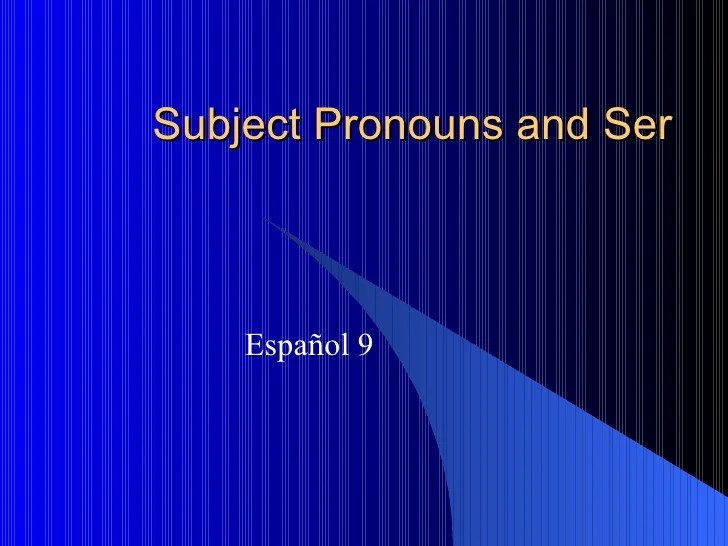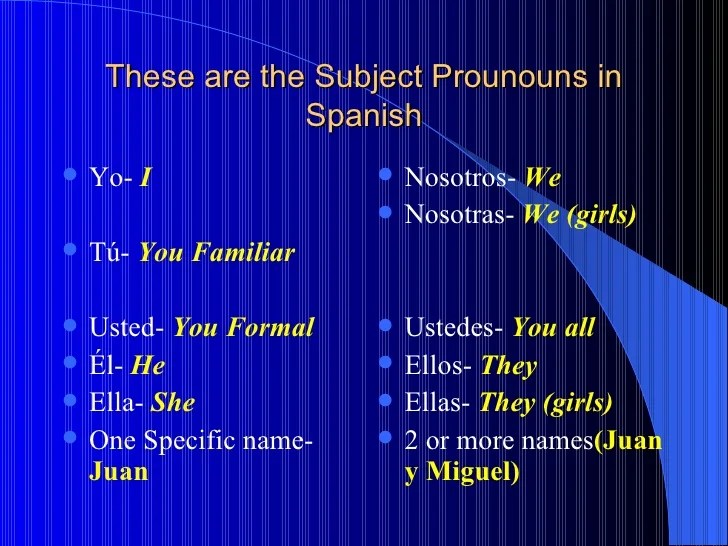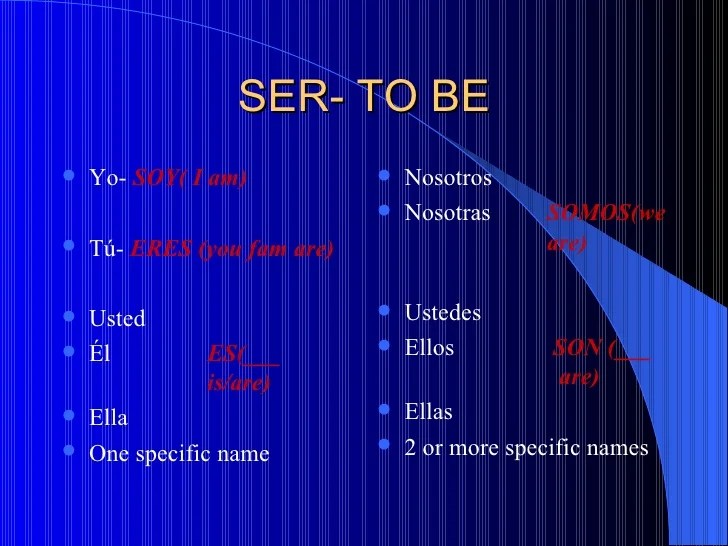Embarking on an exploration of gramatica b subject pronouns and ser, this comprehensive guide unveils the intricacies of Spanish grammar, providing a roadmap for learners to navigate the nuances of subject pronouns and the versatile verb “ser”.
Delving into the heart of Spanish grammar, this discourse elucidates the fundamental concepts of subject pronouns, their diverse forms and functions, alongside the conjugation and usage of the verb “ser” across various tenses.
Subject Pronouns in Spanish Grammar: Gramatica B Subject Pronouns And Ser

Concept of Subject Pronouns, Gramatica b subject pronouns and ser
Subject pronouns in Spanish grammar replace the subject of a sentence, which is typically a noun or noun phrase. They are used to indicate the person and number of the subject and are essential for correct sentence construction.
Forms of Subject Pronouns
Spanish subject pronouns have different forms depending on the person and number of the subject:
- First person singular:yo (I)
- Second person singular (informal):tú (you)
- Second person singular (formal):usted (you)
- Third person singular:él/ella (he/she)
- First person plural:nosotros/nosotras (we)
- Second person plural (informal):vosotros/vosotras (you)
- Second person plural (formal):ustedes (you)
- Third person plural:ellos/ellas (they)
Usage of Subject Pronouns
Subject pronouns are typically placed before the conjugated verb in a sentence:
Example: Yohablo español. (I speak Spanish.)
They can also be used to emphasize the subject:
Example: Éles el mejor estudiante. (He is the best student.)
In certain cases, subject pronouns can be omitted when the context makes it clear who the subject is:
Example: Hablo español. (I speak Spanish.)
The Verb “Ser” in Spanish Grammar

The verb “ser” is one of the most important verbs in Spanish. It means “to be” and is used to describe the essential qualities of a person, place, or thing. “Ser” is also used to talk about nationality, profession, and origin.
Conjugation of the Verb “Ser”
The verb “ser” is conjugated differently depending on the person and tense. The following table shows the conjugation of “ser” in the present tense:
| Person | Conjugation |
|---|---|
| yo | soy |
| tú | eres |
| él/ella/usted | es |
| nosotros/nosotras | somos |
| vosotros/vosotras | sois |
| ellos/ellas/ustedes | son |
Examples of Sentences Using the Verb “Ser”
- Yo soy estudiante. (I am a student.)
- Tú eres mi amigo. (You are my friend.)
- Él es profesor. (He is a teacher.)
- Nosotros somos españoles. (We are Spanish.)
- Vosotros sois muy amables. (You are very kind.)
- Ellos son mis padres. (They are my parents.)
Subject Pronouns and the Verb “Ser” in Sentences

Subject pronouns are used together with the verb “ser” to indicate the subject of a sentence. The verb “ser” means “to be” and is used to describe essential characteristics or qualities of the subject.
Using Subject Pronouns with the Verb “Ser”
The following table shows the subject pronouns and their corresponding verb forms of “ser”:
| Subject Pronoun | Verb Form of “Ser” |
|---|---|
| yo | soy |
| tú | eres |
| él | es |
| ella | es |
| nosotros | somos |
| vosotros | sois |
| ellos | son |
| ellas | son |
To form a sentence using a subject pronoun and the verb “ser”, simply combine the two elements. For example:
- Yo soy estudiante.
- Tú eres inteligente.
- Él es alto.
- Ella es amable.
- Nosotros somos amigos.
- Vosotros sois simpáticos.
- Ellos son trabajadores.
- Ellas son guapas.
Rules for Using Subject Pronouns with the Verb “Ser”
The following rules apply when using subject pronouns with the verb “ser”:
- The subject pronoun must agree in number and person with the subject of the sentence.
- The verb “ser” must be conjugated to match the subject pronoun.
- The subject pronoun can be omitted in Spanish sentences if the context makes it clear who the subject is.
Examples of Subject Pronouns and the Verb “Ser” in Context

In Spanish, subject pronouns are used to indicate the subject of a verb, while the verb “ser” is used to describe essential characteristics or states of being. Together, subject pronouns and the verb “ser” form the foundation of many Spanish sentences.
Here are some real-world examples of how subject pronouns and the verb “ser” are used in Spanish:
In News Articles
“Yo soy periodista y escribo sobre política.”(I am a journalist and I write about politics.)
In this sentence, the subject pronoun “yo” indicates that the speaker is the subject of the verb “soy” (I am), and the verb “ser” describes the speaker’s occupation.
In Literature
“Tú eres mi mejor amigo.”(You are my best friend.)
In this sentence, the subject pronoun “tú” indicates that the person being addressed is the subject of the verb “eres” (you are), and the verb “ser” describes the relationship between the speaker and the person being addressed.
In Everyday Speech
“¿Quién es él?”(Who is he?)
In this sentence, the subject pronoun “él” indicates that the person being referred to is the subject of the verb “es” (is), and the verb “ser” identifies the person being referred to.
These examples demonstrate how subject pronouns and the verb “ser” are essential for conveying meaning and structure in Spanish sentences.
Practice Exercises

Practice exercises are essential for students to reinforce their understanding of subject pronouns and the verb “ser” in Spanish sentences. These exercises should range from basic to advanced levels to accommodate students of varying proficiency.
The exercises should be designed to provide students with ample opportunities to practice using subject pronouns and the verb “ser” in context. They should also include clear instructions and answer keys to facilitate self-assessment and feedback.
Basic Exercises
- Fill in the blanks with the correct subject pronoun:
- Translate the following sentences into Spanish, using the correct subject pronoun and the verb “ser”:
- Write a short paragraph about yourself, using subject pronouns and the verb “ser” to describe your characteristics.
Intermediate Exercises
- Translate the following text into Spanish, using the correct subject pronouns and the verb “ser”:
- Write a dialogue between two people, using subject pronouns and the verb “ser” to introduce themselves and describe their backgrounds.
- Create a table that lists the subject pronouns, their English translations, and examples of their use in sentences.
Advanced Exercises
- Analyze a Spanish text and identify the subject pronouns and the verb “ser” used in the text.
- Write an essay that discusses the use of subject pronouns and the verb “ser” in Spanish grammar.
- Create a presentation that explains the rules for using subject pronouns and the verb “ser” in Spanish.
Essential FAQs
What are subject pronouns in Spanish grammar?
Subject pronouns replace nouns or noun phrases, indicating the person or thing performing the action of the verb.
How do I conjugate the verb “ser” in the present tense?
For the present tense, the conjugation of “ser” is: yo soy, tú eres, él/ella/usted es, nosotros/nosotras somos, vosotros/vosotras sois, ellos/ellas/ustedes son.
Can you provide an example of a sentence using a subject pronoun and the verb “ser”?
Example: Yo soy un estudiante. (I am a student.)
